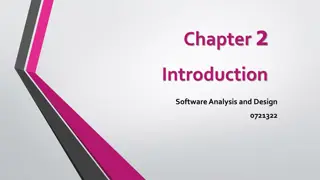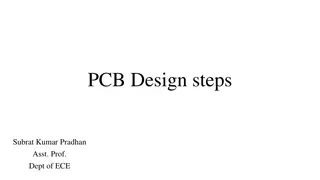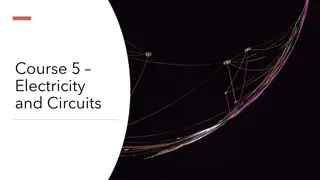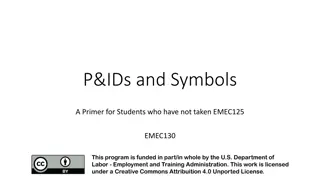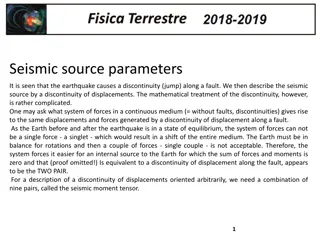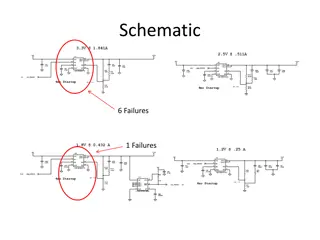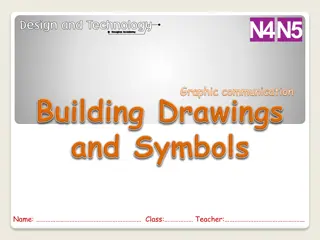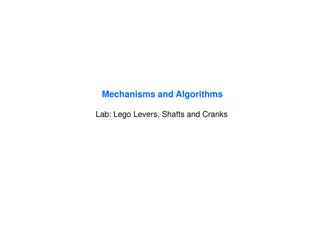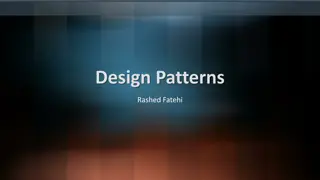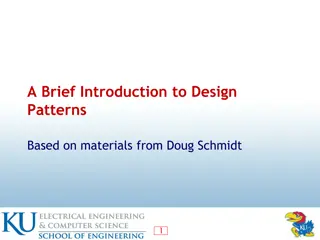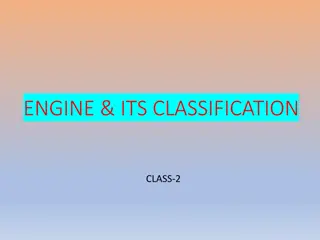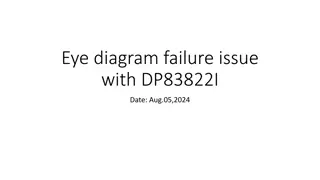SN65DSI85-Q1 Layout Review
In-depth analysis and review of the layout design for the 2026 Nissan CDC Headunit utilizing the SN65DSI85-Q1 system. The review includes detailed information on various layers such as Layer1 to Layer10, the schematic representation, and the block diagram outlining the PMIC Cluster ASIL-B setup. Key
0 views • 13 slides
Software Analysis and Design Process
Software analysis and design involve a systematic approach to understanding user requirements, creating logical models, and transitioning to detailed design specifications. Requirements analysis focuses on capturing system requirements, while design translates these requirements into implementation
8 views • 16 slides
Guide to PCB Design Steps by Subrat Kumar Pradhan, Asst. Prof. Dept. of ECE
Subrat Kumar Pradhan, an Assistant Professor in the Department of ECE, outlines the essential steps in designing a PCB. Starting from defining functionality and researching components to creating the system schematic, interacting with schematic parts, wiring connections, and laying out the PCB, this
5 views • 13 slides
Flowcharts for Document Management
Flowcharts are visual representations that depict the logical flow of processes within a system or program. They serve as communication tools and aid in documentation. Flowcharts follow specific guidelines such as top-to-bottom creation starting from the left of a page. Each activity within a flowch
6 views • 21 slides
Electricity and Circuits: Basics, Components, and Applications
This educational course covers topics such as circuit symbols, calculating and measuring electrical quantities, identifying circuits, and understanding the relevance of electricity in engineering. It explains essential circuit components like energy sources, conductors, insulators, loads, control de
12 views • 30 slides
P&IDs and Symbols in Process Engineering
An insightful primer on P&IDs and symbols for students unfamiliar with EMEC125 and EMEC130 courses. The article delves into the definition of P&IDs as schematic diagrams illustrating the relationship between instruments, controllers, piping, and equipment. It explores the widely understood acronym "
1 views • 32 slides
Guidelines for Design of Cement Concrete Pavement and Interlocking Paver Blocks
This document provides guidelines for designing cement concrete pavements and interlocking paver blocks, covering factors governing design, wheel loads, design period, subgrade characteristics, approximate k values based on CBR values, and the importance of a sub-base below concrete pavements. It em
0 views • 67 slides
Software Engineering Design Principles and Concepts
The chapter discusses the essential principles and concepts in software design, highlighting the four key design models - data design, architectural design, interface design, and component-level design. It emphasizes the importance of traceability to the analysis model, minimizing the gap between so
2 views • 36 slides
Seismic Source Parameters in Earthquake Dynamics
The seismic source parameters in earthquake dynamics involve describing a fault as a discontinuity causing displacements, requiring a complex treatment of forces. The Earth's equilibrium necessitates a specific system of forces to explain displacements along faults. The seismic moment tensor, consis
4 views • 32 slides
Visual Insights into Schematic Failures and Bench Analysis
Explore detailed images showcasing schematic failures, analysis from schematics, web bench inputs, and re-compilation processes. Gain a deeper understanding of these visual representations in the context of technical failures and web bench activities.
0 views • 4 slides
Overview of Loop Diagrams in Process Control Systems
Loop diagrams are essential documents in process control systems, providing schematic representations of hydraulic, electric, magnetic, or pneumatic circuits. They detail instrumentation arrangements, signal connections, power connections, and termination information. Guidelines and standards for cr
1 views • 5 slides
PCB Design Best Practices and Tips
Discover the comprehensive process of PCB design, from the initial vision to schematic capture, component placement, and route tracing using tools like Eagle PCB. Learn about various package types, general tips for layout optimization, and recommendations for placing power and ground traces effectiv
0 views • 21 slides
Conducting a BLDC Gate Driver Schematic Review and Debug Process
Exploring how to effectively review and debug a Brushless-DC (BLDC) motor driver schematic, focusing on locating EVM hardware files, understanding schematic recommendations, detecting errors, and providing valuable feedback. The process involves utilizing available resources to create, review, and d
0 views • 30 slides
Design Inspiration and Elements in Costume and Fashion Design
Dive into the world of costume and fashion design through a visual journey of finding design inspiration, understanding the design process, emphasizing originality, and exploring different sources of creativity. Discover how technology, art, food, history, architecture, and nature can spark innovati
0 views • 45 slides
Building Drawings in Graphic Communication
Building drawings play a crucial role in the construction industry, providing detailed plans for architects, builders, plumbers, electricians, and joiners. These drawings include location plans, floor plans, sectional views, elevations, and schematic diagrams, each serving a specific purpose in the
0 views • 11 slides
Paleoweathering of Paleosols in the Lake Superior Region
Explore the localities and ages of Paleoproterozoic granitic paleosols in the Lake Superior region through schematic profiles, A-C*N-K plots, compositional changes in saprolite relative to protolith, variation with depth, reconstruction of CIA and K2O in metasomatized samples, and mass balance equat
0 views • 17 slides
Enhancing Piping Design Efficiency with Spec-Driven Technology
Explore how Spec-Driven Piping technology powered by CADACTIVE offers a standardized approach for piping design in Creo Parametric. This innovative extension streamlines design communication, eliminates errors, and improves design efficiency by utilizing a master catalog, automated checking capabili
0 views • 15 slides
Mechanisms and Algorithms Lab Experiments
Explore the world of mechanisms and algorithms through engaging lab experiments involving Lego levers, shafts, cranks, electronics schematic drawings, and more. Learn essential concepts like reciprocating motion, understanding part roles, troubleshooting techniques, and rapid prototyping. Gain hands
0 views • 22 slides
Spatial Amplification in Disk-on-Rod Traveling-Wave Amplifier Study
Explore the viability of Disk-on-Rod Traveling Wave Tube (TWT) for high-power microwave devices with wide bandwidth. Analyze the spatial amplification rate through hot-tube dispersion relations, comparing against Particle-in-Cell code simulations. Schematic diagrams and cold-tube dispersion relation
0 views • 13 slides
Material Design: Combining Classic Design Principles with Technological Innovation
Material Design is a design language that combines traditional design principles with the possibilities offered by technology and science. It emphasizes visual language, classic design elements, and innovation to create delightful user experiences. The Material Metaphor, Imagery, Typography, Color,
0 views • 34 slides
Comprehensive Guide to System Design Components and Techniques
System design involves the detailed planning and identification of components in an information system, aiming to provide users with a general understanding of the new system. This process includes techniques like flowcharts, prototyping, and component design, covering aspects such as output design,
0 views • 24 slides
Feedback Loop Compensation Design Using UCC28740 for Voltage Regulation
Explore the detailed design and control laws for a feedback loop compensation system using UCC28740 in a flyback regulator schematic diagram. The control law profile in CV mode, multiple control regions, and gain blocks are discussed for achieving high efficiency in voltage regulation. Gain blocks d
2 views • 16 slides
Design Patterns: A Comprehensive Overview
Exploring the world of design patterns, this content delves into the essence of design patterns, their application in software design to resolve complexity, and the different types of design patterns - creational, structural, and behavioral. It also showcases examples of popular design patterns such
0 views • 22 slides
Layout and Electrical Rules Check by KANTHARAJU P.K.
Layout rules check is essential in preparing masks for fabrication processes to ensure accuracy. Key design rules include minimum width, spacing, enclosure, and extension. Electrical rules checking (ERC) methodology is used to verify design robustness against electronic design rules at schematic and
0 views • 15 slides
Basic Concepts in Software Design
Software design involves transforming customer requirements into a form suitable for implementation, with activities categorized into preliminary and detailed design stages. High-level design focuses on module identification and control relationships, while detailed design entails defining data stru
1 views • 24 slides
Mitochondria: A Visual Overview for Researchers
Dive into the world of mitochondria with a collection of detailed figures, showcasing thin section views, fluorescent protein labeling, schematic representations of mitochondrial compartments, and involvement in processes like apoptosis and biogenesis. Discover the intricate structures and functions
0 views • 12 slides
Mitochondria: Images and Insights for Researchers
Dive into the world of mitochondria with a collection of informative images showcasing aspects like mitochondrial reticulum, fluorescent protein labeling, electron micrograph views, and schematic diagrams of mitochondrial compartments. Learn about metabolic pathways, cellular energy control, mTOR si
0 views • 20 slides
Windmill Project Management Overview
The Windmill project, led by PDR Scott Strycker, Koosha Daneshi, and Ian Nelson, involves a windmill design without a gearbox. The project includes a work breakdown structure, Gantt chart, level two functional decomposition, schematic, and risk mitigation plan. Key risk mitigation strategies include
0 views • 6 slides
Schematic Design Review for Project UF-100 Century Tower
During the Schematic Design phase of the UF-100 Century Tower project, the committee will assess the building footprint, site layout, and tree removal plans. The presentation guidelines outline key aspects to cover, such as project overview, site plan, tree impacts, and mitigation strategies. Visual
0 views • 9 slides
Design Patterns in Object-Oriented Design
Design patterns in object-oriented design (OOD) are essential templates that codify best practices for solving common problems. They help streamline development by capturing proven design decisions, promoting code reuse, and enhancing system flexibility and modularity. Learn about the core concepts,
0 views • 20 slides
Significance of the Cell Cycle in Growth and Development
This resource focuses on the cell cycle in the context of growth, development, and proliferation. It covers the significance of cell division, similarities in unicellular and multicellular organisms, the importance of CDK-mediated phosphorylation, and more. Students will learn to create schematic de
0 views • 24 slides
Interaction Design in Human-Computer Interaction
Interaction design focuses on creating interactive products that are easy, effective, and enjoyable to use. It aims to reduce negative user experiences while enhancing positive ones. Designing interactive products requires understanding user activities, interfaces, and device arrangements to support
0 views • 11 slides
SE2811 Software Component Design Overview
This course covers software component design, design patterns, object-oriented design, algorithms, and opportunities for reuse in systems design. It emphasizes the importance of domain-level design and provides insights into solving core problems through reusable classes.
1 views • 21 slides
Analysis of Bunch Lengthening in CEPC for Different Design Parameters
This study explores bunch lengthening in the Circular Electron Positron Collider (CEPC) for various design parameters, analyzing a 54 km design scheme, a 61 km design scheme, and a 100 km design scheme. The analysis includes the theoretical framework used, equations for bunch lengthening, and conclu
1 views • 15 slides
Plain & Reinforced Concrete Structures in Design Engineering
In the design of Plain & Reinforced Concrete structures, various strength design methods such as Ultimate Strength Design (USD) and Allowable Strength Design (ASD) are utilized. These methods involve factors of safety, material strength, load factors, and analysis in the elastic range. Additionally,
0 views • 11 slides
Verilog Adder Examples & Typical IC Design Flow
This comprehensive content delves into Verilog adder examples, typical IC design flow, physical design considerations, and examples of OpenGL ES GPU and ARM hypervisor applications. It covers the fundamentals of digital logic with Verilog design, hardware description language, FPGA prototyping, phys
1 views • 27 slides
PCB Design Tutorial Steps & Interactions
Learn the step-by-step process of designing a PCB, from breaking down functionality into modules to creating the system schematic, wiring connections, and PCB layout. Discover tips for component selection, interaction with schematic parts, and ensuring proper design rules are followed.
0 views • 13 slides
The Standard Agreement Between Owner and Architect AIA Document B101
In this document, explore the AIA Document B101, which outlines the standard form of agreement between an owner and architect. Learn about the architect's basic services, including schematic design, design development, construction documents phases, additional services, termination or suspension cla
0 views • 35 slides
Engine Classification and Design
Engine classification involves categorizing engines based on various factors such as combustion type, number of strokes, cylinder design, and ignition method. Common classifications include external and internal combustion engines, as well as categories based on the design and use of the engine. Add
0 views • 11 slides
Troubleshooting Eye Diagram Failure Issue with DP83822I in Fiber Optic Schematic
Utilizing the Tektronix MSO 70404C oscilloscope and differential probe for testing, the customer encounters failure in the eye diagram test with the DP83822 IC. Suggested solutions from the BU and potential configuration of Reg0x0027 register in DP83822I to meet the eye diagram test requirements are
0 views • 5 slides

